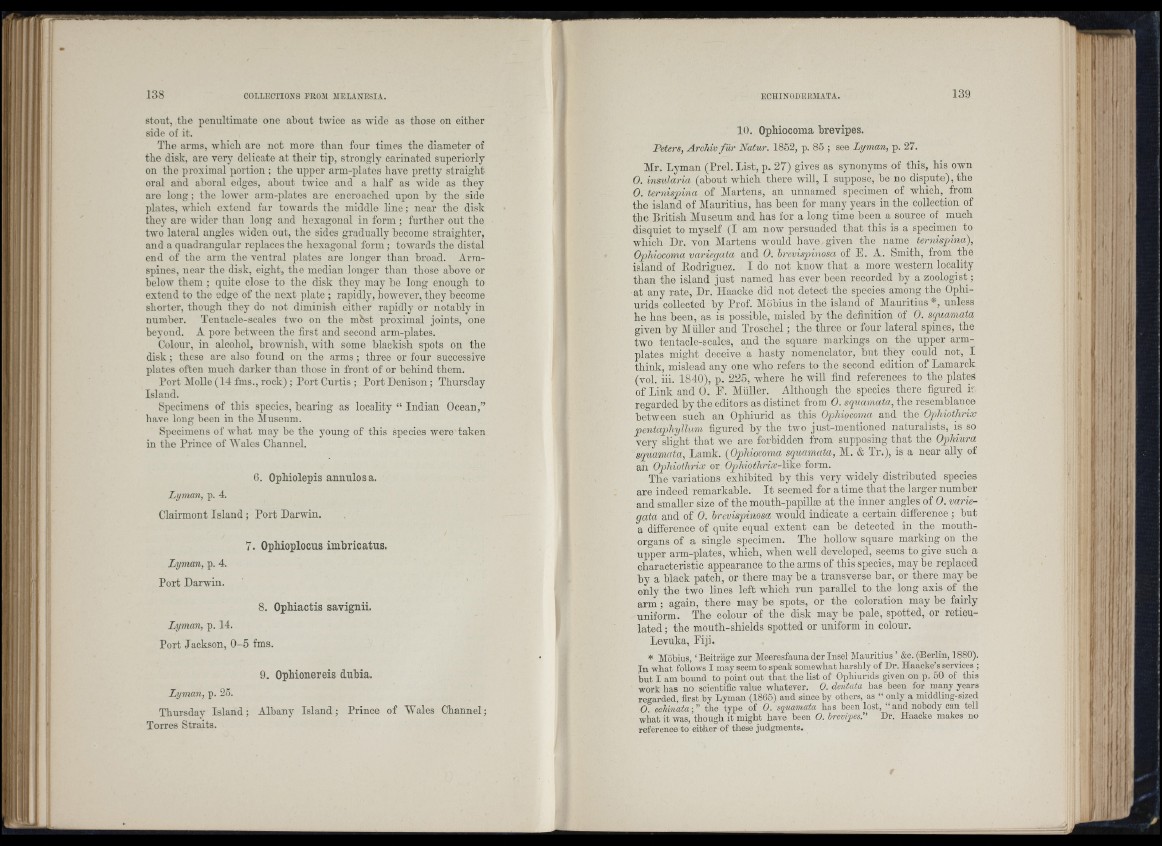
stout, the penultimate one about twice as wide as those on either
side of it.
Tho arms, whieh are not more than four times the diameter of
the disk, aro very delicate at their tip, strongly carinated superiorly
on the proximal portion ; the upper arm-plates have pretty straight
oral and aboral edges, about twice and a half as wide as they
are lo n g ; the lower arm-plates are encroached upon by the side
plates, which extend far towards the middle lin e ; near the disk
they are wider than long and hexagonal in fo rm ; further out the
two lateral angles widen out, the sides gradually become straighter,
and a quadrangular replaces tho liexagonal form; towards the distal
end of the arm the ventral plates are longer than broad. Arm-
spines, near the disk, eight, the median longer than those above or
below them ; quite close to the disk they may be long enough to
extend to tho edge of the next plate ; rapidly, however, they become
shorter, though thej’ do not diminish either rapidly or notably in
number. Tentacle-scales two on the mbst proximal joints, one
beyond. A pore between the first and second arm-plates.
Colour, in alcohol, brownish, with some blackish spots on the
disk ; these are also found on the a rm s; three or four successive
plates often much darker than those in front of or behind them.
Port MoPe (IP fms., rock); Port Curtis ; Port Denison; Thursday
Island.
Specimens of this species, hearing as locality “ Indian Ocean,”
have long been in the Museum.
Specimens of what may be the young of this species were taken
in the Prince of AA’ales Channel.
6. Ophiolepis annulosa.
Lyman, p. 4.
Clairmont Island ; Port Darwin.
7. Ophioplocus imbricatus.
Lyman, p. 4.
Port Darwin.
8. Ophiactis savignii.
Lyman, p. 14.
Port Jackson, 0 -5 fms.
9. Ophionereis duhia.
Lyman, p. 25.
Thursday Island ; Albany Isla n d ; Prince of AA*ales Channel;
Torres Straits.
10. Ophiocoma brevipes.
Peters, Archiv fü r Natur. 1852, p. 85 ; see Lyman, p. 27.
Mr. Lyman (Prel. List, p. 27) gives as synonyms of this, his own
0. insularia (about which there will, I suppose, be no dispute), the
0. ternisqmia of Martens, an unnamed specimen of which, from
the island of Mauritius, has been for many years in the collection of
the British Museum and has for a long time been a source of much
disquiet to myself ( I am now persuaded th a t this is a specimen to
which Dr. von Martens would have given the name ternispina),
Ophiocoma variegata and 0. hrevisptinosa of E. A. Smith, from the
island of Rodriguez. I do not know that a more western locality
than the island ju st named has ever been recorded by a zoologist;
at any rate, Dr. Haacke did not detect the species among the Ophiurids
collected by Prof. Möbius in the island of Mauritius *, unless
he has been, as is possible, misled by the definition of 0. squamata
given by Miiller and Trosch e l ; the three or four lateral spines, the
two tentacle-scales, and the square markings on the upper arm-
plates might deceive a hasty nomenclátor, bnt they could not, I
think, mislead any one who refers to the second edition of Lamarck
(vol. iii. 1840), p. 225, where he will find references to the plates
of Link and 0 . E. Miiller. Although the species there figured i-
regarded by the editors as distinct from 0. squamata, the resemblance
between such an Ophinrid as this Ophiocoma and the Ophiothrix
pentaphyUum figured by the two just-mentioned naturalists, is so
very slight th at we are forbidden from supposing th at the Ophiura
squamata, Lamk. {Ophiocoma squamata, M. & Tr.), is a near ally of
an Ophiothrix or Opthiothrix-likQ form.
The variations exhibited by this very widely distributed species
are indeed remarkable. I t seemed for a time th at the larger number
and smaller size of the mouth-papill® at the inner angles of 0. variegata
and of 0. hrevispinosa would indicate a certain difference ; hut
a difference of quite equal extent can he detected in the mouth-
organs of a single specimen. The hollow square marking on the
upper arm-plates, which, when well developed, seems to give such a
characteristic appearance to the arms of this species, may be replaced
by a black patch, or there may he a transverse bar, or there may be
only the two lines left which run parallel to the long axis of the
a rm ; again, there may be spots, or the coloration may he fairly
uniform. The colour of the disk may he pale, spotted, or reticulated;
the mouth-shields spotted or uniform in colour.
Levuka, Fiji.
* Möbius, ‘ Beiträge zur Meeresfauna der Insel Mauritius ’ &c. (Berlin, 1880).
In what follows I may seem to speak somewhat harshly of Dr. Haacke’s services ;
but I am bound to point out that the list of Ophiurids given on p. 50 of this
work has no scientific value whatever. 0. dentata has been for many years
regarded, first by Lyman (1865) and since by others, as “ only a middling-sized
0. echinata;’’ the type of 0. squamata has been lost, “ and nobody can tell
what it was, though it might have been 0. hrcvipes." Dr. Haacke makes no
reference to either of these judgments.
:!
A H ,1,
1